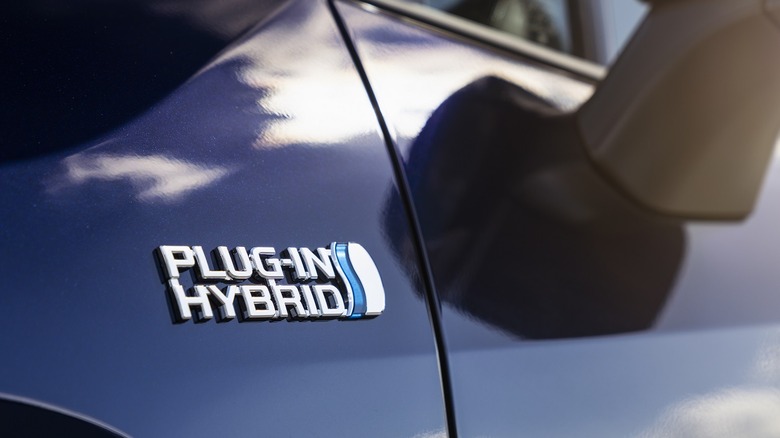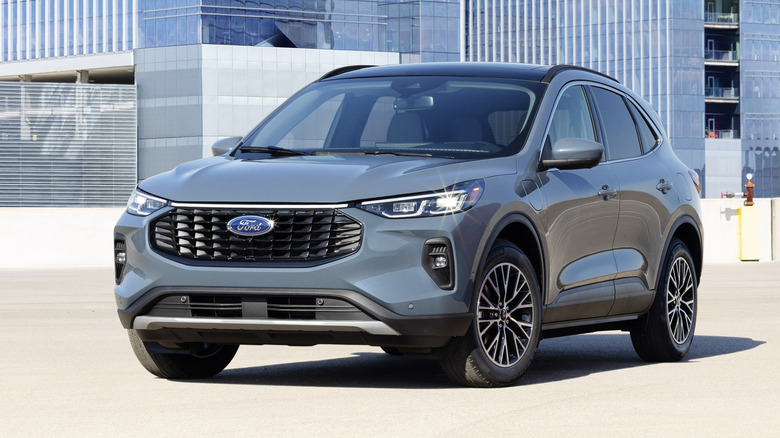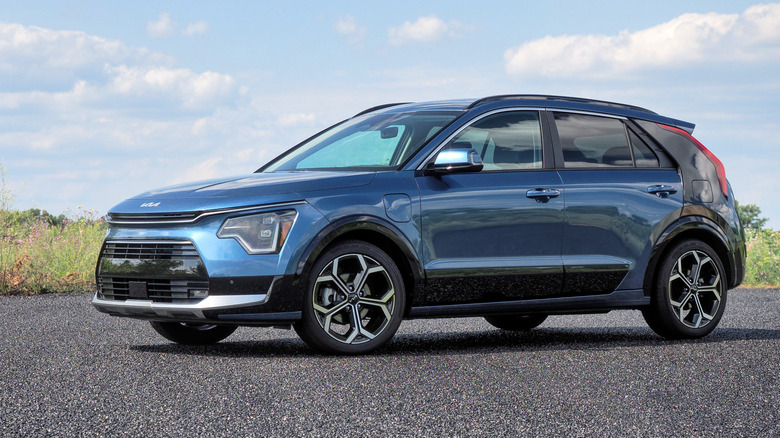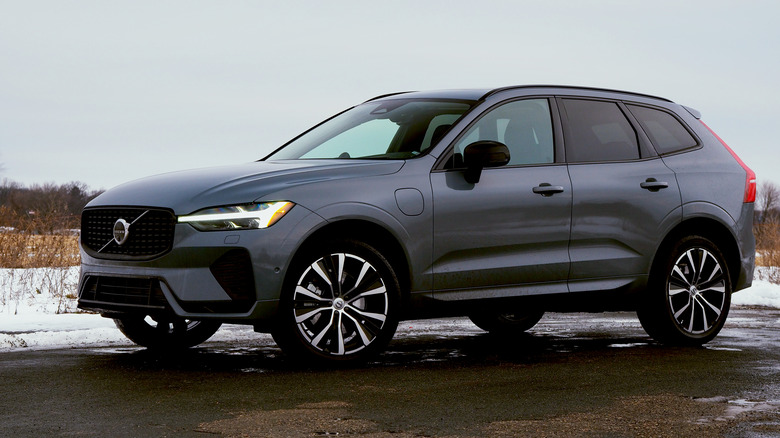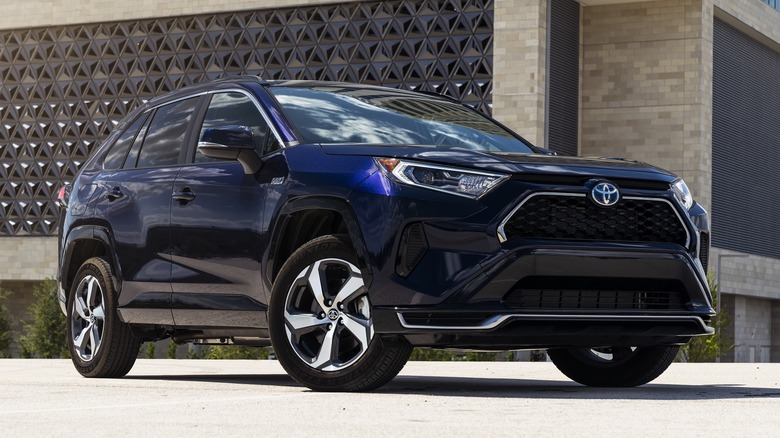5 Of The Best Plug-In-Hybrids You Need To Check Out If You Want A New SUV
There are some very good reasons why, even if you know your next car needs an electric motor, a plug-in hybrid or PHEV might still be the best option. Range anxiety may be the bogeyman haunting many potential EV buyers, but it's an inescapable fact that, for some drivers, hitting the road for longer trips is not the exception but the norm.
Being able to rely on the familiarity — and easy refueling — of a gas engine for those journeys, while still driving on electric power alone for shorter errands, in many ways feels like the best of both worlds. PHEVs may fall short of fully electric cars when it comes to battery range alone, but factor in a full gas tank and you're looking at hundreds of miles for typically far less at the dealership than you spend on a comparative EV. If you're in the market for a plug-in hybrid SUV, these are five that should definitely be on your shortlist.
Ford Escape PHEV
With the demise of the Chevrolet Volt, you might be wondering what a would-be PHEV owner on a budget is meant to be driving. The answer could well be Ford's Escape PHEV, the plug-in hybrid version of its compact crossover SUV. Starting at $40,500 — and eligible for up to $3,750 in U.S. federal tax incentives — it certainly checks off the affordable part.
Ford combines that aggressive pricing with flexibility. There are 37 miles of electric-only range, basically suggesting that the Escape PHEV could satisfy the typical daily driving of the average American on a single charge. Once the 2.5-liter gas engine kicks in, the total range extends to 520 miles; 1,500 pounds of towing capacity is a bonus, on top of niceties like a power liftgate and 13.2-inch touchscreen infotainment system.
Roam through the options list, and it's possible to turn Ford's little PHEV into a positively luxurious electrified crossover: available features include parking assistance, a B&O audio system, and leather seats. Still, the Escape PHEV arguably makes the most sense in its cheapest form, bringing the flexibility of a plug-in hybrid to a market perhaps not quite ready for a full EV.
Jeep Wrangler 4xe
Of all the SUVs to go electric, the iconic Wrangler might not top your list of candidates. All the more impressive, then, that Jeep's Wrangler 4xe straddles the divide between go-anywhere off-roader and gas-sipping hybrid so compellingly. In fact, you could make a solid argument that, out of the entire Wrangler family, the 4xe makes the most sense.
At first glance, you'd be forgiven for not realizing it was electrified at all. Subtle blue highlights are the primary giveaway, along with the charging port on the front fender. Fully charged, there's a healthy 49 miles of electric-only range, but it's how Jeep implements the Wrangler 4xe's gas and electric combination that makes it special.
There's no missing out on off-road must-haves like front and rear locking differentials, and 31.5 inches of water fording depth mean you're sacrificing nothing of a non-PHEV Wrangler's capabilities. With 470 lb-ft of torque, meanwhile, it actually matches the fearsome Wrangler Rubicon 392 with its beefy V8. The 392, however, doesn't get the Wrangler 4xe's $3,750 U.S. federal tax incentive to offset the plug-in hybrid's $54,735 starting price.
Kia Niro PHEV
You can't accuse Kia of not playing the spread: its new Niro comes in three flavors of electrification, from a mild-hybrid to a fully electric version. In the middle is arguably the most flexible of the bunch, the Niro PHEV combining 33 miles of electric range with the convenience of up to 510 miles of total driving when the gas engine weighs in.
Is the Niro PHEV really an SUV? According to Kia it is, and for its size, the compact crossover certainly isn't short on practicality. It also benefits from some of the automaker's most convenient tech, like Highway Driving Assist, rear cross-traffic collision avoidance assist, and blind spot detection. Under the latest U.S. federal tax incentive rules, the 2023 Niro PHEV doesn't qualify. However its $33,840 starting price is undeniably aggressive out of the gate, and it's worth noting that state and energy provider subsidies might still be available.
Volvo XC60 Recharge
Volvo has several new all-electric SUVs in the pipeline, with the EX30 at one size extreme and the EX90 at the other. That doesn't mean there's no electrification on the dealership forecourt already, though, with plug-in hybrid versions of multiple SUVs, sedans, and wagons. The sweet spot may well be the XC60 Recharge.
Like other Volvo models, the midrange SUV starts with a 2.0-liter turbocharged four-cylinder gas engine. To that, it adds an electric motor and a battery with 35 miles of range. With all-wheel drive as standard, the PHEV is actually among the fastest Volvo SUVs, with a zero to 60 mph time of just 4.5 seconds. It also gets a 3,500-pound tow rating.
Inside, Volvo's own particular flavor of Scandinavian luxury continues to impress, and a recent upgrade to a Google-powered dashboard keeps the tech feeling fresh. Indeed, the only real downside is the absence of a U.S. tax incentive to take away some of the sting from the $57,200 starting price.
Toyota RAV4 Prime
Toyota may have popularized the mass-market mild hybrid, but it arguably took the RAV4 Prime before the automaker was seen as taking plug-in hybrids seriously. Combining one of Toyota's best-selling designs with standard all-wheel drive and 42 miles of electric-only range, it's no slouch, either. In fact, with 302 horsepower in total, it's actually the most powerful RAV4 in the line-up.
Sadly there are no U.S. federal tax incentives to bite away at the $43,090 starting price, but two well-equipped trims salve some of that disappointment. 2,500 pounds of towing capacity is standard, and while it's hard to imagine potential owners cross-shopping them, the RAV4 Prime can actually out-accelerate a Toyota GR Supra 2.0. The Supra, though, lacks space for five inside, or the RAV4 Prime's decent-sized trunk. Toyota then adds a solid list of active safety technology and covers scheduled servicing for the first two years.
